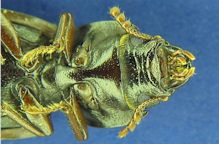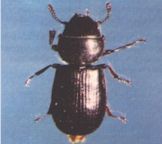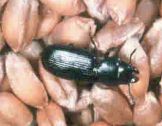


|
|
Cadelle
 |
 |
 |
| Common Name | Cadelle |
| Scientific Name | Tenebroides mauritanicus (Linnaeus) |
| Size | Slim, flat 6-11mm long, 8mm large |
| Colour | Shiny dart to red brown black in colour. Brown to black, ventral side, antennae and legs are red-brown |
| Description | This is one of the largest stored grain insects and is black in
color. The larvae burrow into the woodwork of bins and can stay there to
infest new grain. These larvae are white with black heads and two horny,
black points at the end of their bodies. One particular feature is the lining between wing covers and neck shield, whose front outer corners extend towards the head. The dirty-white larva, 15-18 mm long, has a black head, behind this a black shield, two black hooks at the end of the body and long body hairs. The yellowish-white pupa is 7-10 mm long. The Cadelle’s underside, antennae, and legs are red-brown. There is a distinct narrowing of the body between the prothorax and wing covers which gives the appearance of a distinct "waist." The outer corners of the prothorax project forward toward the head. Cadelle larvae, the worm-like immature stages, have creamy white elongate bodies with distinct black heads. There are two dark plates on the upper part of the segment just behind the head. A distinct plate with two horny points is present on the rear of the larvae. The largest of the food pests; is also known as the bread beetle or bolting cloth beetle. |
| Habitat | Since the beetle's life cycle extents to nearly a year,
it is more common in old grain bins and flour mills. External feeder of corn, rice, flour, cereals, oats, potatoes, nuts, spices, fruits, etc Both larvae and adults will bore into wood surfaces during their development cycle. |
| Lifecycle | 3 to 14 months The female deposits some 500-1,000 eggs in clusters in the grain or grain products over the course of several months. The entire development period is about 1 year in temperate zones and up to 3 generations per year in the tropics. In mills, the larvae are mainly found in clumps of Mediterranean flour moth webs, but also in cracks in timber. Before pupation, the larvae bore into wood or make a bed of flour and other materials. The larvae hibernate before pupation. The adults are long lived, often more than a year Females may live more than a year and lay an average of 1,000 eggs each. The eggs are laid in batches of 10 to 60 in the grain or food materials. Both larvae and adults attack grain and typically go from kernel to kernel, feeding on the germ. There are usually four larval stages and one or two generations of the insect per year in temperate regions. Larval development may be as short as eight weeks under optimum conditions. The larvae often migrate from the source of the infestation to pupate in a hole within wood or other materials. Eggs and pupae are easily killed at 0 degrees C. The larval stage requires 2-14 months |
| Disease Transmitted | None recorded |
| Symptoms | N/A |
| Type of damage | Cadelles eat mainly different types of grains, flour, and meal. They
produce irregular holes in undamaged kernels. Cadelles are primary feeders on a variety of grains, flour, and meal. They produce irregular holes in undamaged kernels and prefer the seed germ but will also eat endosperm. This beetle is commonly found in wooden bins. Both larvae and adults will bore into wood surfaces during their development cycle. The cadelle is a beetle that is not common in stored grain. here they are destructive to sifting equipment. The cadelle adults attack grain kernels and destroy the germ. Larvae bore into woody materials or timbers in grain bins or storerooms to pupate. |
| Sources / breeding | World-wide |
| Prevention | Prevention is always the most economic and efficient method of controlling these pests. Once they are distributed within the grain mass, fumigation is the best method of relieving the problem. |
| Control |
|
[ Home Page ]